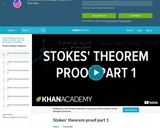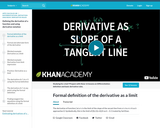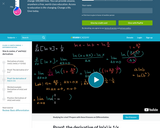
This series of videos focusing on calculus covers parameterizing a surface, surface integrals, stokes' theorem.
- Subject:
- Calculus
- Mathematics
- Material Type:
- Lecture
- Provider:
- Khan Academy
- Provider Set:
- Khan Academy
- Date Added:
- 05/28/2013

High quality mathematics resources for remote high school learning from the CK-12 Foundation, EngageNY, Illustrative Mathematics, and Khan Academy. You can refine the collections by selecting different fields, such as material types, on the left side of the page, under Filter Resources.

This series of videos focusing on calculus covers parameterizing a surface, surface integrals, stokes' theorem.

You can parameterize a line with a position vector valued function and understand what a differential means in that context already. This tutorial will take things further by parametrizing surfaces (2 parameters baby!) and have us thinking about partial differentials.

You know what Stokes' theorem is and how to apply it, but are craving for some real proof that it is true. Well, you've found the right tutorial!

Finding line integrals to be a bit boring? Well, this tutorial will add new dimension to your life by explore what surface integrals are and how we can calculate them.

This series of videos focusing on calculus covers calculating derivatives, power rule, product and quotient rules, chain rule, implicit differentiation, derivatives of common functions.

You can take the derivatives of f(x) and g(x), but what about f(g(x)) or g(f(x))? The chain rule gives us this ability. Because most complex and hairy functions can be thought of the composition of several simpler ones (ones that you can find derivatives of), you'll be able to take the derivative of almost any function after this tutorial. Just imagine.

Discover what magic we can derive when we take a derivative, which is the slope of the tangent line at any point on a curve.

The topic that is now known as "calculus" was really called "the calculus of differentials" when first devised by Newton (and Leibniz) roughly four hundred years ago. To Newton, differentials were infinitely small "changes" in numbers that previous mathematics didn't know what to do with. Think this has no relevence to you? Well how would you figure out how fast something is going *right* at this moment (you'd have to figure out the very, very small change in distance over an infinitely small change in time)? This tutorial gives a gentle introduction to the world of Newton and Leibniz.

We told you about the derivatives of many functions, but you might want proof that what we told you is actually true. That's what this tutorial tries to do!

This problem involves the meaning of numbers found on labels. When the level of accuracy is not given we need to make assumptions based on how the information is reported. The goal of the task is to stimulate a conversation about rounding and about how to record numbers with an appropriate level of accuracy, tying in directly to the standard N-Q.3. It is therefore better suited for instruction than for assessment purposes.

The purpose of this task is to give students practice constructing functions that represent a quantity of interest in a context, and then interpreting features of the function in the light of that context. It can be used as either an assessment or a teaching task.

The primary purpose of this task is to lead students to a numerical and graphical understanding of the behavior of a rational function near a vertical asymptote, in terms of the expression defining the function. The canoe context focuses attention on the variables as numbers, rather than as abstract symbols.

The purpose of this task is to use finite geometric series to investigate an amazing mathematical object that might inspire students' curiosity. The Cantor Set is an example of a fractal.

The task requires the student to use logarithms to solve an exponential equation in the realistic context of carbon dating, important in archaeology and geology, among other places. Students should be guided to recognize the use of the natural logarithm when the exponential function has the given base of e, as in this problem. Note that the purpose of this task is algebraic in nature -- closely related tasks exist which approach similar problems from numerical or graphical stances.

In the task "Carbon 14 Dating'' the amount of Carbon 14 in a preserved plant is studied as time passes after the plant has died. In practice, however, scientists wish to determine when the plant died and, as this task shows, this is not possible with a simple measurement of the amount of Carbon 14 remaining in the preserved plant. The equation for the amount of Carbon 14 remaining in the preserved plant is in many ways simpler here, using 12 as a base.

This problem introduces the method used by scientists to date certain organic material. It is based not on the amount of the Carbon 14 isotope remaining in the sample but rather on the ratio of Carbon 14 to Carbon 12. This ratio decreases, hypothetically, at a constant exponential rate as soon as the organic material has ceased to absorb Carbon 14, that is, as soon as it dies. This problem is intended for instructional purposes only. It provides an interesting and important example of mathematical modeling with an exponential function.

This exploratory task requires the student to use a property of exponential functions in order to estimate how much Carbon 14 remains in a preserved plant after different amounts of time.

This task lets students explore the concept of independence of events. There are two alternative ways of solving the problem.

This simple task assesses whether students can interpret function notation. The four parts of the task provide a logical progression of exercises for advancing understanding of function notation and how to interpret it in terms of a given context.

The purpose of this task is to use geometric and algebraic reasoning to model a real-life scenario. In particular, students are in several places (implicitly or explicitly) to reason as to when making approximations is reasonable and when to round, when to use equalities vs. inequalities, and the choice of units to work with (e.g., mm vs. cm).